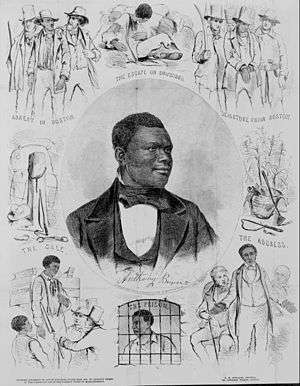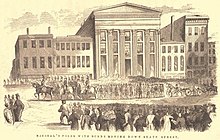Anthony Burns
Anthony Burns (31 May 1834 – 17 July 1862) was a fugitive slave whose recapturing, extradition, and court case led to wide-scale public outcries of injustice, and ultimately, increased opposition to slavery by Northerners.

Burns was born a slave in Stafford County, Virginia. As a young man, he became a Baptist and a "slave preacher" at the Falmouth Union Church in Falmouth, Virginia. In 1853, he escaped from slavery and reached Boston, where he started working.
The following year, he was captured under the Fugitive Slave Act of 1850 and tried in court. The Fugitive Slave Act was despised and fiercely resisted in Boston, and Burns' case attracted national publicity, including large demonstrations, protests, attacks, and violence. Federal troops were employed to ensure Burns was transported without interference to a ship headed back to Virginia post-trial.
Burns was eventually ransomed from slavery, with his freedom purchased by Boston sympathizers. Afterwards, he was educated at Oberlin Collegiate Institute and became a Baptist preacher, moving to Upper Canada for a position, where he remained until his death.
Flight from slavery and capture
In 1853, nineteen-year old Anthony Burns escaped his enslavement to Colonel Charles F. Suttle in Richmond. He traveled by ship to Boston, in the free state of Massachusetts. In Boston, he worked for a pie company and for Coffin Pitts, a clothing dealer at 36 Brattle Street.[1]
On May 24, 1854, he was discovered "while walking in Court Street" and arrested.[1] As a hub of resistance to the "slave power" of the South, Boston had numerous residents who tried to free Burns. President Franklin Pierce made an example of the case to show he was willing to strongly enforce the Fugitive Slave Act. The show of force turned many New Englanders against slavery who had passively accepted its existence before.
On May 26, before Burns' court case, a crowd of both black and white abolitionists, including Thomas Wentworth Higginson and other Bostonians outraged at Burns' arrest, stormed the courthouse to free the man.[2] In the melee, Deputy U.S. Marshal James Batchelder was fatally stabbed,[3] the fourth U.S. Marshal to be killed in the line of duty.[4] The police kept control of Burns, but the crowds of opponents, including such black abolitionists as Thomas James and Lewis Hayden, grew large.[5] While the federal government sent US troops in support, numerous anti-slavery activists arrived in Boston to join the protest and continue the faceoff. It has been estimated the government's cost of capturing and conducting Burns through the trial was upwards of $40,000 (equivalent to $1,138,000 in 2019).[6]
Trial and aftermath
We went to bed one night old-fashioned, conservative, compromise Union Whigs & waked up stark mad Abolitionists.

Burns's trial was a formality as the requirements of the Fugitive Slave Act were clear and did not require much documentation on the part of slaveholders or their representatives. Richard Henry Dana, Jr. and his associate, the prominent black lawyer Robert Morris, acted as Burns' defenders, but were not successful in the case. United States Commissioner and Suffolk County, Massachusetts, probate court judge Edward G. Loring remanded Burns to his owner, Charles F. Suttle, of Alexandria, Virginia.[8]
Following the decision against Burns, the government effectively held Boston under martial law for the afternoon. The streets between the courthouse and the harbor were lined with federal troops to hold back the waves of protesters as Burns was escorted to the ship for return to his Virginia master. On June 2, throngs in the city witnessed Burns' being taken to the ship that would carry him back to slavery in Virginia.
The matter did not end after Burns was transported south. The events generated strong opposition across the North to Pierce and his administration. Massachusetts residents formed an Anti-Man Hunting League; William Lloyd Garrison burned copies of the Fugitive Slave Act, the Burns court decision, and the Constitution of the United States; and, as a result of the efforts of the Boston Vigilance Committee to lobby the legislature and governor against him, Edward G. Loring, the judge who tried Burns, was removed from office in 1857. (The next year Loring was appointed to the United States Court of Claims under President James Buchanan.) In a broader sense, the Burns case fueled anti-slavery sentiments all across the North.
Grand jury
A grand jury indicted three of those involved in the attack at the courthouse. After an acquittal of one man and several hung juries in trials for the others, the federal government dropped the charges.[9]
Freedom and later life
The abolitionist community were willing to pay $1,200 to buy Burns' from his master, Charles F. Suttle, but Suttle refused to deal with anyone seeking Burns' emancipation. After Burns was transported to Virginia, Suttle sold him for $905 to David McDaniel, a slaver, cotton planter, and horse-dealer from Rocky Mount, North Carolina.
Reverend Leonard A. Grimes of Boston's Twelfth Baptist Church led efforts to raise money for the purchase of Anthony Burns' freedom. Acting through intermediaries, Grimes purchased Burns, who then returned to Massachusetts a free man.[6]
With proceeds that came from publication of his biography, combined with a scholarship, Burns received an education at Oberlin Collegiate Institute in Ohio. After briefly preaching in Indianapolis, Burns emigrated about 1860 to Upper Canada to accept a call from Zion Baptist Church in that colony.[10] He served as a non-ordained minister until his early death from tuberculosis at the age of 28 in St. Catharines on July 17, 1862.[11]
See also
| Wikimedia Commons has media related to Anthony Burns. |
- Slavery in Massachusetts, Henry David Thoreau's reaction to the Burns trial
References
- Boston slave riot, and trial of Anthony Burns. Fetridge and Company. 1854. p. 5. Retrieved April 26, 2013.
- Kathleen R. Zebley (2000). "Anthony Burns". In David S. Hedler and Jeanne T. Hedler (ed.). Encyclopedia of the American Civil War. p. 326. ISBN 0-393-04758-X.
- Charles Emery Stevens (1856). "Anthony Burns: A History". p. 43.
- "Roll Call of Honor". Retrieved May 26, 2009.
- Thomas James (1886). "Life of Rev. Thomas James, by Himself". Documenting the American South. University of North Carolina (original publisher: Rochester, NY: Post Express). Retrieved June 3, 2010.
- "'Trial' of Anthony Burns". Massachusetts Historical Society. Retrieved May 10, 2010.
- James M. McPherson (1989). Battle Cry of Freedom: The Civil War Era. New York: Bantam Books. p. 120.
- "Anthony Burns captured". www.pbs.org. Retrieved 2018-02-05.
- Steven E. Barkan (October 1983). "Jury Nullification in Political Trials". 31 (1). Social Problems: 28–44. Cite journal requires
|journal=(help) - Archaeological and Historic Sites Board of Ontario. "Rev. Anthony Burns 1834-1862". Historical Marker Database. Retrieved December 1, 2019.
- Von Frank, Albert J. The Trials of Anthony Burns: Freedom and Slavery in Emerson's Boston. Harvard University Press, 1998, p305
Bibliography
- Barker, Gordon S. Imperfect Revolution: Anthony Burns and the Landscape of Race in Antebellum America, Kent State University Press, 2011
- "Anthony Burns Biography (1834–1862)." A&E Television Networks. 2007. <http://www.biography.com/search/article.do?id=9232120%5B%5D>
- "Anthony Burns (1834–1862)", Black Abolitionist Archive, University of Detroit Mercy. <http://image.udmercy.edu/BAA/Anthony_Burns.html%5B%5D>
- Stewart, James Brewer. Holy Warriors: The Abolitionists and American Slavery, revised edition. New York: Hill and Wang, 1996.
- Tuttleton, James W. Thomas Wentworth Higginson, Twayne Publishers, pp. 34–36
Further reading
- PBS Resource Bank: People and Events: Anthony Burns captured, 1854
- Ronica Roth (2003): "The Trial of Anthony Burns", in Humanities, May/June 2003, Volume 24/Number 3.
- Virginia Hamilton, Anthony Burns: The Defeat and Triumph of a Fugitive Slave
- Gordon S. Barker, The Imperfect Revolution: Anthony Burns and the Landscape of Race in Antebellum America
- Henry David Thoreau (July 4, 1854): "Slavery in Massachusetts"
- Walt Whitman, "A Boston Ballad"
- . Appletons' Cyclopædia of American Biography. 1900.
External links
- Anthony Burns at Virginia Memory